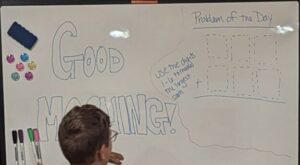When my dad took us on long road trips as a kid, he would give my brother and I what he called “can problems.” Iowa used to have, and still has, a bottle deposit law where each returned soda can or bottle was worth a nickel.
So my dad would ask us to solve how many cans we would need to collect to earn $1,000. There were a lot of ways to alter the problem—what if we had to pay for trash bags to hold the cans? Or what if we drove them to Michigan, where each can was worth a whole dime?! The point was to distract us from boredom and maybe do a little mental math in the process.
When I became a father, my kids didn’t like “can problems” as much as I did, but they liked doing the free “Bedtime Math” app and playing Math Games with Bad Drawings by Ben Orlin.
How do other parents incorporate math into their daily lives? When I put this question out on social media, I got a lot of great responses. What follows is my compilation, sorted by topic.
Daily life applications
In turns out that parents have found lots of ways to embed math concepts into their daily lives. Lindy Funaki, a technical writer and editor in nuclear operations, mentioned having kids classify and sort toys by shapes and patterns or using car trips to count vehicles by color or type; making comparisons (e.g., faster/slower, closer/farther, bigger/smaller, more/less); and figuring expected arrival times.
Shannon White-Benson, a contracts and grants manager, had her daughter practice counting when she couldn’t get to sleep. As a result, her daughter knew how to count to 100 before she was two and a half!
Other parents ask their kids to do math in exchange for something they want. For example, Samanatha Sifleet, a data scientist and machine learning engineer, had her 4th grader calculate the sales tax on any purchases they planned to make.
 In order to agree to a family dog, Rebecca Shah from the Mission Delivery Network made her kids make a budget for it and then track the related expenses. That required both some basic math work as well as financial literacy skills.
In order to agree to a family dog, Rebecca Shah from the Mission Delivery Network made her kids make a budget for it and then track the related expenses. That required both some basic math work as well as financial literacy skills.
Erin Lair, who works with small and rural schools at the Oregon Department of Education, pointed out that the 4-H program teaches a lot of math skills. Participants need to calculate animal growth rates as a function of feeding costs and then make profit calculations. She had her 3rd and 5th graders make cost-benefit calculations for things like comparing whether it was better financially to own chickens or to buy eggs at a grocery store.
Haley Spira-Bauer, the Chief Academic Officer at Fullmind Learning, offered a list of things she asked her kids to do, including estimating how much money they would need to add to their lunch card to cover the full year, based on last year’s data; budgeting birthday money among different priorities; estimating everything (like guessing how many toys might be in a toy chest and explaining why); calculating driving distance and the ideal gas/rest stop locations along the way, along with optimal snack purchases and consumption; measuring furniture and calculating the amount of paint they would need for a redecorating project; and graphing to aggregate information in a visual format (such as Halloween candy, presents received on a birthday, toys in the backyard, etc.).
Food, cooking, and baking
Cooking and baking were the most common answers about how parents ask their kids to use math. As one example, Colleen Dippel, the Chief Executive Officer at Families Empowered, would have her kids follow a recipe from scratch—not just a box mix—and then ask them to double or halve it. This got them using whole numbers and fractions; doing addition and multiplication; and measuring weight, time, and temperature. Plus, at the end, they got to eat what they made!
Sarah Sandelius, the Founder and CEO at The Ability Challenge, used math to help her kids get through mealtime. She would ask questions like, “If you have 10 chicken nuggets and you eat 2, how many are left?” She says it helped build math skills while also getting her kids to eat.
Shana Young, a leader in residence at the Yale School of Management, also uses food and cooking to teach math lessons. She emphasized the timing aspect of cooking by asking her kids to answer questions around cooking times and sequencing. Her kids have also started to calculate the effects of “shrinkflation” on their favorite snacks.
Games and sports
Karin Chenowith, the Founder of Democracy and Education, grew up playing cribbage with her father, whose college degree was in math. She got really good at all the combinations of 15 and 21 and adding in her head. Shah from the Mission Delivery Network noted that her kids love playing games like Adsumudi, or Yahtzee when they were younger.
Ashley Darcy Mahoney, a neonatal nurse practitioner and senior associate dean at George Washington University, noted that her kids nailed the multiplication of 7’s and 3’s at especially young ages thanks to watching NFL games and thinking through all the permutations of touchdowns and field goals.
Math problems
Sometimes parents, like my dad and his “can problems,” ask kids to do math problems as a way to master math facts or just to counteract boredom or offer additional enrichment opportunities.
Dominic Imwalle, a senior consultant at Deloitte, admits that he struggled with the times tables as a kid (specifically 8 x 7), so his mom printed out of a ton of worksheets, and he’d have to finish one or two before he could go play with friends. He says it worked and he never forgot them after that!
Hardly anyone uses a checkbook nowadays, but Patrick Talmadge Harris, who works in procurement at EdtTrax, noted that his dad made him reconcile his checkbook as a kid.
Julie Grove, the Vice President for K-12 Math Solutions at HMH*, really walks the walk. At her house, she puts a “Problem of the Day” up on giant whiteboards in a common area. The kids aren’t required to do them, but the changing nature of the problems and the physical proximity makes the kids more likely to try them out.
Grove shared a couple examples with me. In one, she asked her kids to calculate how many boxes could fit inside a cube of various sizes. The problem starts with a 2x2x2 cube and then moves up to a 3x3x3 one. As a challenge, it asks the kids to figure out how many cubes would fit inside 4x4x4, 5x5x5, or 6x6x6 cubes.
 As another example, Grove asked her kids to use the digits 1-6 to make the largest possible sum. The kids had to use place value to solve a standard addition algorithm adding two, three-digit numbers with “blank” spots to be filled in.
As another example, Grove asked her kids to use the digits 1-6 to make the largest possible sum. The kids had to use place value to solve a standard addition algorithm adding two, three-digit numbers with “blank” spots to be filled in.
Bill Gartner, a Senior Vice President at Cisco Systems, said his kids liked to do logic games. For example, he might ask how a farmer could get a hen, a fox, and a bag of seed across the river with one boat if the fox eats the hen, and the hen eats the seed? He liked these types of problems because they help with critical thinking and problem-solving skills, and they allow kids to pursue multiple (sometimes hysterically creative) paths. In his house, the solutions often involved salt and pepper shakers or various household items to aid with visualization.
We’re all solvers
Recently, the Collaborative for Student Success launched the “We’re All Solvers” campaign. Their mission is to, “elevate a new narrative about math education—one that centers possibility and real-world relevance for all students.” Hopefully the variety of examples cited above give parents some inspiration for what they might do to help their kids see themselves as math people.
*Disclosure: I work with the HMH and NWEA teams on policy consulting work.

